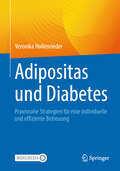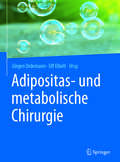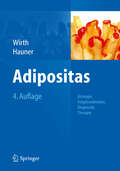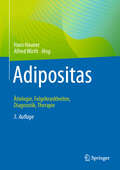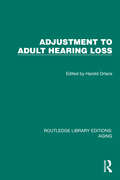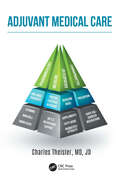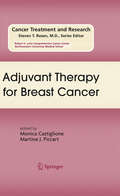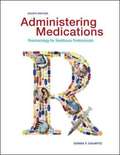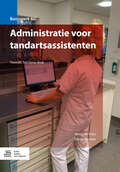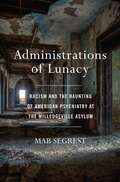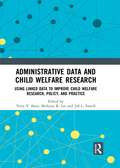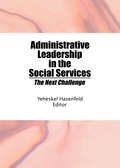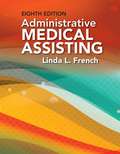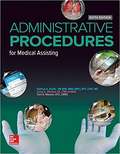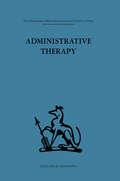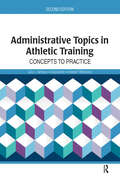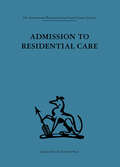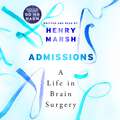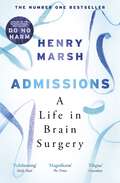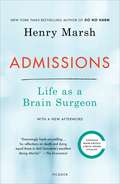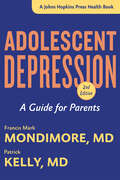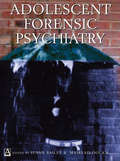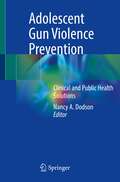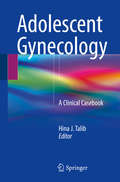- Table View
- List View
Adipositas und Diabetes: Praxisnahe Strategien für eine individuelle und effiziente Betreuung
by Veronika HollenriederDie stetig wachsende Zahl an Patienten mit Adipositas und Diabetes stellt eine zunehmende Herausforderung für Ärzte aller Fachrichtungen und unser Gesundheitssystem dar. Eine adäquate Betreuung der Erkrankten ist langwierig, zeit- und kostenintensiv. Dieses Fachbuch soll zu einem tieferen Verständnis für die komplexen Problematiken von Adipositas und Diabetes beitragen. Es bietet nicht nur theoretisches Wissen, sondern auch praktische Werkzeuge, um die Lebensqualität der Betroffenen nachhaltig zu verbessern. Das Buch vermittelt Basiswissen zu Ursachen, Diagnostik, Therapie und Risiken beider Erkrankungen. Darüber hinaus werden anhand von Fallbeispielen praxisnahe Lösungsansätze zur Umsetzbarkeit der therapeutischen Empfehlungen im Alltag dargestellt. Es widmet sich der Frage, wie Ressourcen zielgerichtet eingesetzt werden können und eine individualisierte Betreuung mit reduziertem Zeitaufwand möglich ist. Dabei wird auch die Arzt-Patienten-Kommunikation beleuchtet, die eine zentrale Rolle für einen möglichen Therapieerfolg spielt. Die im Anhang beigefügten Arbeitsblätter, Checklisten und Fragebögen sollen dabei unterstützen, Lösungsansätze für Patienten zeiteffizient zu erarbeiten. Eine unverzichtbare Ressource für Ärzte, aber auch angrenzende Therapieberufe wie Ernährungs- und Diabetesberater.
Adipositas- und metabolische Chirurgie
by Jürgen Ordemann Ulf ElbeltPraxisorientiert und detailliert sind in diesem Buch die chirurgische Therapie der Adipositas und die metabolische Chirurgie dargestellt. Die einzelnen Operationsverfahren mit ihren spezifischen Indikationen, Durchf#65533;hrung und Risiken werden in Wort und Bild ausf#65533;hrlich beschrieben. Besonderer Wert wird auf die Auswahl des geeigneten Operationsverfahrens f#65533;r den einzelnen Patienten gelegt. Neben den Wirkmechanismen, die den Operationsverfahren zugrunde liegen, und der vorangehenden konservativen Therapie werden die vorgeschalteten formalen Schritte, die Operationsvorbereitung und die postoperative Nachsorge erl#65533;utert. Au#65533;er chirurgischen werden auch internistische und psychosomatische Komplikationen ausf#65533;hrlich dargestellt. Informationen zur Gr#65533;ndung und Zertifizierung eines Adipositaszentrums und ein Ausblick auf neue Entwicklungen der bariatrischen Therapie runden den Band ab.
Adipositas: Ätiologie, Folgekrankheiten, Diagnostik, Therapie
by Alfred Wirth Hans HaunerEtwa 65 % der Deutschen sind übergewichtig - starkes Übergewicht beeinträchtigt die Lebensqualität und führt häufig zu Diabetes, Stoffwechselstörungen, Hypertonie und Gelenkbeschwerden. Der Band bietet Fachleuten, die mit adipösen Patienten arbeiten, das notwendige Wissen zu Grundlagen, Diagnostik und Therapie der Adipositas und ihren Folgekrankheiten. Die Inhalte sind leicht verständlich dargestellt und an den Leitlinien der Fachgesellschaften ausgerichtet. Mit Praxistipps, Hinweisen auf Fehlerquellen und Kurzzusammenfassungen.
Adipositas: Ätiologie, Folgekrankheiten, Diagnostik, Therapie
by Alfred Wirth Hans HaunerEs ist „normal“, nicht normalgewichtig zu sein. Die Adipositas ist mehr als eine Befindlichkeitsstörung, sie ist eine Krankheit, eine Volkskrankheit.Was sind die Grundlagen und Ursachen? Psychologisch und physiologischGenetische Faktoren und UmweltfaktorenDysregulation von Hunger und Sättigung sowie des EnergiestoffwechselsFolgekrankheiten Vom Diabetes bis zu KarzinomenVom Fersensporn bis zur WirbelsäulendegenerationVon der Stigmatisierung bis zur Essstörung Welche Therapie ist wann sinnvoll? Keine Crashdiäten – langfristige ErnährungsumstellungAdipositasgerechte BewegungstherapieVerhaltensmodifikation, ggf. VerhaltenstherapieBariatrische Chirurgie als ultima ratio NEU u.a. Digitale Ansätze zur GewichtssenkungNeue MedikamenteStabilisierung des GewichtserfolgsModerne laparoskopische Adipositaschirurgie Nach den Leitlinien DAG, Deutsche Adipositas-GesellschaftDGE, Deutsche Gesellschaft für ErnährungDGEM, Deutsche Gesellschaft für ErnährungsmedizinDDG, Deutsche Diabetes-Gesellschaft DAS Nachschlagewerk, das alle Bereiche der Adipositas umfassend, interdisziplinär darstellt. Für alle Fachleute, die in Krankenhäusern, Reha-Kliniken und niedergelassenen Praxen mit adipösen Patienten arbeiten: Ärzte (Internisten, Allgemeinmediziner, Pädiater, Gynäkologen, Endokrinologen …), Ernährungsfachkräfte, Klinische Psychologen, Psychotherapeuten, Bewegungstherapeuten, Gesundheitsberater …
Adjustment to Adult Hearing Loss (Routledge Library Editions: Aging)
by Harold OrlansOriginally published in 1985, the chapters in this book were, with two exceptions, first prepared for and discussed at a monthly research seminar series on Hearing Loss in Adulthood during the 1983-1984 academic year. One of the exceptions was included to fill a major gap in the literature dealing with the experience of persons who suffer a moderate hearing loss in midlife. The other, by the editor, presents his observations and reiterates significant points made by a number of seminar members. As a whole this book shines a light on the experience of hearing-impaired people, particularly the loss of hearing in later life.
Adjuvant Medical Care
by Charles TheislerDespite tremendous gains in medical knowledge, most conditions are managed, rather than cured, by medications. As a result, countless patients seek supplemental modes of care to better control their symptoms and conditions to improve their overall wellbeing. This reality spotlights the need for adjuvant medical procedures. Adjuvant medical care refers to any supportive therapy that enhances the outcome of medical measures already in place. Adjuvant care does not replace primary or traditional treatments, but instead serves as add-on care to the initial medical treatment plan prescribed by a health care provider. The addition of one or more non-prescription therapies (e.g., nutritional support, over-the-counter remedies, home care, dietary measures, supplements, etc.) to the primary medical management regimen has become increasingly popular and mainstream thanks to scientific studies that have documented favorable outcomes for many patients. The verifiable scientific merit of these additional medical options demonstrates their usefulness in the treatment of many medical conditions. The purpose of this handbook is to provide support to doctors and patients who are interested in safe and effective non-prescription and non-pharmacological medical therapies for specific conditions to minimize symptoms and optimize recovery and quality of life. • Helps doctors and patients discover additional therapies that can reduce pain, advance health outcomes, minimize complications and disability, and extend life. • Presents safe, reliable, and practical options that are available to reduce symptoms, maximize recovery, and positively augment the management of a variety of conditions. • Provides medical insight into less traditional, yet often effective, supportive options for enhancing and optimizing patient response to care. This book is a valuable resource for both doctors and patients who are committed to achieving the best possible medical outcomes through a variety of coordinated approaches.
Adjuvant Therapy for Breast Cancer (Cancer Treatment and Research #151)
by Martine J. Piccart Monica CastiglioneAdjuvant treatment is administered prior to or as follow up to surgical procedures for breast cancer. Proven success in using medical therapies allowing for breast conserving procedures or reducing risk of occurrence. Although there has been much progress towards a cure, including the introduction of new targeted therapies, metastasizing cancer remains highly incurable.
Administering Medications: Pharmacology for Healthcare Professionals, Eighth edition.
by Donna F. GauwitzAdministering Medications: Pharmacology for Healthcare Professionals is designed to teach the safe administration of medications to healthcare students. The organization of the chapters primarily by body systems allow students and instructors to build a knowledge base that starts with the fundamentals of medication administration and progresses through the drugs frequently used to treat most commonly found disease of the associated body system. The text's many features help break down the various aspects of drug administration, allowing the student to gain a full understanding of when and how to administer medications.
Administratie voor tandartsassistenten (Basiswerk AG)
by Maria de Vries Elly HogeveenDit boek helpt je een goede tandheelkundige administratie te voeren. Het leert je de patiëntenadministratie en de declaraties correct te doen. En je leert hoe je rekening houdt met de wetgeving over het patiëntendossier en de Algemene Verordening Gegevensbescherming. Het boek is bedoeld voor assistenten in opleiding, maar is ook een prima naslagwerk voor medewerkers in de tandheelkundige praktijk.Administratie voor tandartsassistenten bevat uitgebreide informatie over de tandheelkundige zorg in Nederland en handige tips voor het correct voeren van de tandheelkundige administratie. In elk hoofdstuk vind je veel opdrachten die op de dagelijkse praktijk gebaseerd zijn. Online vind je eindopdrachten, extra frontoffice-opdrachten en zijn er bij elk hoofdstuk toetsvragen toegevoegd. Verder vind je online een uitgebreid gefingeerd patiëntenbestand dat je voor de opdrachten kunt gebruiken. Het boek is rijk geïllustreerd en bevat het een afkortingenlijst van tandheelkundige begrippen en een register. Maria de Vries is docent aan de opleiding tot tandartsassistent aan Noorderpoort in Groningen en werkt als praktijkmanager bij Tandartsenpraktijk Burgum. Elly Hogeveen is van oorsprong tandarts- en preventieassistent en verzorgt nu de lessen vaardigheid, administratie en omgangskunde aan de opleiding tot tandartsassistent van ROC Friese Poort.
Administratie voor tandartsassistenten (Basiswerk AG)
by Maria de Vries Elly HogeveenHet voeren van een goede tandheelkundige administratie is ‘een must’ voor iedere tandheelkundige praktijk. Naast de wetgeving omtrent het patiëntendossier is het correct uitvoeren van de patiëntenadministratie en het declareren een voorwaarde om een praktijk financieel gezond te houden. Dit boek helpt je hierbij. De tandheelkundige administratie is constant in beweging. Neem de vrije Tarieven in 2012, het kostenonderzoek door de NZa van de tandheelkundige praktijk in 2014 en het eigen risico van de basisverzekering wat elk jaar stijgt. Daarnaast hebben de zorgverzekeraars een steeds grotere stem aangaande de tandheelkundige zorgverlening welke invloed heeft op zowel de patiënt als de medewerkers van de tandheelkundige praktijk. Het boek Administratie voor tandartsassistenten is in eerste instantie bedoeld voor de assistent in opleiding, maar is ook een prima naslagwerk voor de medewerkers in de tandheelkundige praktijk. Naast uitgebreide informatie over de tandheelkundige zorg in Nederland, vind je veel opdrachten en handige tips bij het correct voeren van de tandheelkundige administratie. Het boek bevat per hoofdstuk veel opdrachten die in de dagelijkse praktijk van toepassing zijn. Daarnaast is het boek rijk geïllustreerd met afbeeldingen en voorbeelden van formulieren. Achterin het boek vind je een afkortingenlijst van tandheelkundige begrippen en een register. Ook tref je achterin het boek een ‘patiëntenbestand’ die je voor de opdrachten kunt gebruiken. Elly Hogeveen is instructeur (en docent Omgangskunde in opleiding) aan de opleiding tot tandartsassistent aan de ROC Friese Poort in Leeuwarden en redactielid van Standby, hét vakblad voor assistenten in de tandheelkunde. Maria de Vries is als docent verbonden aan Noorderpoort in Groningen voor de opleiding tot tandartsassistent. Daarnaast is ze betrokken als hoofdredacteur bij Standby, hét vakblad voor assistenten in de tandheelkunde.
Administrations Of Lunacy: Racism And The Haunting Of American Psychiatry At The Milledgeville Asylum
by Mab SegrestA scathing and original look at the racist origins of psychiatry, through the story of the largest mental institution in the world Today, 90 percent of psychiatric beds are located in jails and prisons across the United States, institutions that confine disproportionate numbers of African Americans. After more than a decade of research, the celebrated scholar and activist Mab Segrest locates the deep historical roots of this startling fact, turning her sights on a long-forgotten cauldron of racial ideology: the state mental asylum system in which psychiatry was born and whose influences extend into our troubled present. In December 1841, the Georgia State Lunatic, Idiot, and Epileptic Asylum was founded. A hundred years later, it had become the largest insane asylum in the world with over ten thousand patients. Administrations of Lunacy tells the story of this iconic and infamous southern institution, a history that was all but erased from popular memory and within the psychiatric profession. Through riveting accounts of historical characters, Segrest reveals how modern psychiatric practice was forged in the traumas of slavery, the Civil War, Reconstruction, and Jim Crow. Deftly connecting this history to the modern era, Segrest then shows how a single asylum helped set the stage for the eugenics theories of the twentieth century and the persistent racial ideologies of our own times. She also traces the connections to today’s dissident psychiatric practices that offer sanity and create justice. A landmark of scholarship, Administrations of Lunacy restores a vital thread between past and present, revealing the tangled racial roots of psychiatry in America.
Administrative Data and Child Welfare Research: Using Linked Data to Improve Child Welfare Research, Policy, and Practice
by Terry V. Shaw, Bethany R. Lee and Jill L. FarrellEvery day, social service agencies collect millions of pieces of data about the children and families they serve. Agencies depend on this data to inform decision-making by personnel throughout the organization and to provide meaningful research and evaluation on program effectiveness and outcomes. As capacity for collecting and utilizing data has increased so has the recognition that this data can and should be used more broadly. Further, it should include not just single-system data, but data across different human service agencies. Administrative/big data systems can be powerful tools in increasing the efficiency and effectiveness of public child welfare services. Understanding, harnessing, and using big data holds tremendous promise in creating transformative change in the social services. Data analytics and data mining can lead to a better understanding of what services work for specific populations (targeting and predictive modelling), provide a more nuanced understanding of service outcomes for the workforce and major stakeholders (transparency), and facilitate collaboration across existing service delivery silos to reduce duplication of services and enhance consumer access to services (efficiency). This book was originally published as a special issue of the Journal of Public Child Welfare.
Administrative Leadership in the Social Services: The Next Challenge
by Yeheskel HasenfeldWhat should be the roles and behavior of administrators to meet the challenges facing social service agencies today? Here is a thought-provoking book that provides a great deal of insight into administrative leadership, an essential component in the survival and effectiveness of social service agencies.In response to the enormous challenges that social service agencies are facing, including justification of their mission, mobilization of resources, and responsiveness to new social needs, experts present theoretical and empirical studies on administrative leadership in the social services, reviewing the most recent theories and research on the relationship between leadership and service effectiveness. They also focus on emerging issues in social work administration, including a description of the role of women in social work administration and an assessment of a feminist model of macro practice; the rise of for-profit social service agencies; management-union relations; and entrepreneurship as a new model for administrators.Administrative Leadership in the Social Services is especially useful for administrators of social service agencies by providing them with insight into their own practice and giving them guidance to improve their administrative effectiveness. To students and scholars, this outstanding new volume presents a review of theories and research on current and emerging issues in social work administration.
Administrative Medical Assisting
by Linda L. FrenchDevelop 21st century skills with ADMINISTRATIVE MEDICAL ASSISTING, 8e! This streamlined learning package delivers step-by-step procedures in front-office medical assisting along with the critical thinking and job skills you need to tackle allied health-related issues in the real world. This proven package addresses fundamental administrative competencies, including professional responsibilities, interpersonal and written communications, records management, financial administration, and managing the office. Simulated test questions, mapped competencies, and updated certification standards add depth to every chapter and prepare you for certification exams. Updated content keeps you abreast of the newest requirements for electronic technology, insurance regulations, coding, health care reform, legal compliance, and much more. Robust and reader-friendly, ADMINISTRATIVE MEDICAL ASSISTING, 8e is essential for medical assistants who want to succeed in today's allied health careers.
Administrative Procedures For Medical Assisting
by Kathryn A. BoothBe on the ball with Administrative Procedures for Medical Assisting, Sixth Edition. Bring essential administrative medical assisting skills to life through the BWW Associates Clinic. Through case studies, sample practice paperwork, soft skills success exercises, Practice Fusion screenshots, and EHR documentation examples, Administrative Procedures teaches you to juggle your many responsibilities first as a student and then as a medical assisting professional.
Administrative Therapy: The role of the doctor in the therapeutic community
by David H ClarkTavistock Press was established as a co-operative venture between the Tavistock Institute and Routledge & Kegan Paul (RKP) in the 1950s to produce a series of major contributions across the social sciences. This volume is part of a 2001 reissue of a selection of those important works which have since gone out of print, or are difficult to locate. Published by Routledge, 112 volumes in total are being brought together under the name The International Behavioural and Social Sciences Library: Classics from the Tavistock Press. Reproduced here in facsimile, this volume was originally published in 1964 and is available individually. The collection is also available in a number of themed mini-sets of between 5 and 13 volumes, or as a complete collection.
Administrative Topics in Athletic Training: Concepts to Practice
by Andrew P. Winterstein Gary Harrelson Greg GardnerAdministrative Topics in Athletic Training: Concepts to Practice, Second Edition continues to be a dynamic text that addresses important administrative issues, practices, and procedures, as well as fundamental concepts, strategies, and techniques related to the management of all aspects of an athletic training health care delivery system. Uniquely, this text balances theory and application around management, administration, and leadership for the athletic trainer in multiple practice settings.Inside the Second Edition, Drs. Gary Harrelson, Greg Gardner, and Andrew Winterstein feature case studies and instructional activities, both within the text and instructor materials, to help athletic training students and clinicians understand and apply the concepts to “real world” scenarios. Numerous graphic elements such as boxes, callouts, tables, and illustrations are included throughout the text to enhance readability.New and updated features to the Second Edition: Numerous case studies, examples, and classroom activities 12 appendices provide tools and examples to aid in the application of concepts and principles addressed in the text Each chapter uses an Advanced Organizer to aid the reader in chapter orientation All chapters have been updated to include changes in laws, regulations and practices Issues in educational and clinical settings are broken into different chapters Chapters have been grouped into three sections to improve flow of the text— Personal Practices, Athletic Training Practices and Organizational Practices Faculty will have access to an Instructor’s Manual, PowerPoint slides, and Test Bank Questions Updated topics inside the Second Edition: Use of social media Multiple generations in the workplace Time management and prioritization Process of writing a business plan Athletic training as a business Starting your own business Administrative models in educational settings Impact of degree transition in athletic training Guidelines for appropriate medical coverage in secondary school and university settings Expanding roles of Athletic Trainers in clinical settings Included with the text are online supplemental materials for faculty use in the classroom.Administrative Topics in Athletic Training: Concepts to Practice, Second Edition provides beneficial information on administrative topics and will be a useful resource for athletic training students, practitioners, and any administrator responsible for supervision of athletic trainers and athletic training service programs.
Admission to Residential Care
by Glenys Jones Gwyneth Roberts Paul Brearley Frank Hall Penny GutridgeTavistock Press was established as a co-operative venture between the Tavistock Institute and Routledge & Kegan Paul (RKP) in the 1950s to produce a series of major contributions across the social sciences. This volume is part of a 2001 reissue of a selection of those important works which have since gone out of print, or are difficult to locate. Published by Routledge, 112 volumes in total are being brought together under the name The International Behavioural and Social Sciences Library: Classics from the Tavistock Press. Reproduced here in facsimile, this volume was originally published in 1980 and is available individually. The collection is also available in a number of themed mini-sets of between 5 and 13 volumes, or as a complete collection.
Admissions: A Life in Brain Surgery
by Henry Marsh'Sensational' SUNDAY TIMES NO. BESTSELLER'Extraordinary...both exhilarating and alarming...fascinating' DAILY MAIL'Wonderful...a testament to the tenacity of the human spirit' FINANCIAL TIMESHenry Marsh has spent four decades operating on the human brain. In this searing and provocative memoir following his retirement from the NHS, he reflects on the experiences that have shaped his career and life, gaining a deeper understanding of what matters to us all in the end.Written and read by Dr Henry Marsh(p) 2017 Orion Publishing Group
Admissions: A Life in Brain Surgery
by Henry Marsh'Sensational' SUNDAY TIMES NO. BESTSELLER'Extraordinary...both exhilarating and alarming...fascinating' DAILY MAIL'Wonderful...a testament to the tenacity of the human spirit' FINANCIAL TIMESHenry Marsh has spent four decades operating on the human brain. In this searing and provocative memoir following his retirement from the NHS, he reflects on the experiences that have shaped his career and life, gaining a deeper understanding of what matters to us all in the end.
Admissions: Life as a Brain Surgeon
by Henry MarshThe International Bestseller"Consistently entertaining...Honesty is abundantly apparent here--a quality as rare and commendable in elite surgeons as one suspects it is in memoirists." —The Guardian"Disarmingly frank storytelling...his reflections on death and dying equal those in Atul Gawande's excellent Being Mortal." —The EconomistHenry Marsh has spent a lifetime operating on the surgical frontline. There have been exhilarating highs and devastating lows, but his love for the practice of neurosurgery has never wavered. Following the publication of his celebrated New York Times bestseller Do No Harm, Marsh retired from his full-time job in England to work pro bono in Ukraine and Nepal. In Admissions he describes the difficulties of working in these troubled, impoverished countries and the further insights it has given him into the practice of medicine. Marsh also faces up to the burden of responsibility that can come with trying to reduce human suffering. Unearthing memories of his early days as a medical student, and the experiences that shaped him as a young surgeon, he explores the difficulties of a profession that deals in probabilities rather than certainties, and where the overwhelming urge to prolong life can come at a tragic cost for patients and those who love them.Reflecting on what forty years of handling the human brain has taught him, Marsh finds a different purpose in life as he approaches the end of his professional career and a fresh understanding of what matters to us all in the end.
Adolescent Depression: A Guide for Parents (A Johns Hopkins Press Health Book)
by Patrick Kelly Francis Mark MondimoreThe timely second edition of this bestselling guide will inform and encourage struggling adolescents and their families.In Adolescent Depression, psychiatrists Francis Mark Mondimore, MD, and Patrick Kelly, MD, explain that serious depression in adolescents goes beyond "moodiness." Depression is in fact an illness—one that can be effectively treated. The authors describe the many forms of depression and the many symptoms of depression in young people—from sadness to irritability, self-harm, drug and alcohol abuse, and violent rages. Incorporating the latest research from the field of adolescent psychiatry, this comprehensive and compassionate guide answers questions that many parents have, including What are the symptoms of depression in teenagers? How is depression diagnosed? What is the difference between depression and bipolar disorder, and which does my child have? How can I find the best mental health professional team for my child? What kinds of counseling and psychotherapy are available? Are medications safe, and how does a doctor choose a medication for my child? What can I do if my adolescent is using alcohol, crystal meth, marijuana, or other substances? How do autism and Asperger's syndrome, eating disorders, premenstrual dysphoric disorder, ADHD, and disruptive mood dysregulation disorder interact with depression? What should I do if I sense that my child is in danger? With all of this going on, how can I take care of myself?
Adolescent Forensic Psychiatry
by Susan Bailey Mairead DolanAdolescent Forensic Psychiatry discusses a broad range of issues based around the psychiatric needs of adolescents and how these relate to offending behaviour. Its well-structured approach looks at assessment, treatment and outcomes for different disorders and highlights the importance of effective interaction between specialist agencies. Services
Adolescent Gun Violence Prevention: Clinical and Public Health Solutions
by Nancy A. DodsonEach year, gun violence kills approximately 2,700 and injures approximately 14,500 children in the U.S.; the overwhelming majority of child gun deaths are among teenagers who die by homicide or suicide. Gun violence is the leading cause of death for Black teens. A recent spate of high-profile tragedies involving children, such as the Newtown mass shooting in 2012 and the Parkland mass shooting in 2018, have reinvigorated a national debate about the role of guns in our private and public spaces. Physicians, and in particular pediatricians, have become increasingly vocal about the need to address the epidemic of gun violence in the U.S.This book serves as an in-depth, comprehensive guide to adolescent gun violence prevention. It describes the epidemiology of teen gun violence in the U.S. by focusing on the parallel epidemics that claim the most lives: gun suicide among rural white males, and gun homicide among urban Black males. It offers in-depth reviews of key concepts that are crucial to reaching a meaningful understanding of gun violence. The text also addresses specific methods of intervention at various levels of society, from the individual; to the local community; and finally to the entire nation. This first of its kind book is a valuable reference for physicians, public health scientists, policy-makers, gun reform advocates, and anyone interested in working towards a safer future for young people.
Adolescent Gynecology: A Clinical Casebook
by Hina J. TalibThis book offers a comprehensive and clinically relevant survey of adolescent gynecology. Adolescent Gynecology: A Clinical Casebook addresses the many intersecting considerations of gynecologic and reproductive health care for this population using a concise, case-based format. Organized in four sections, the first introduces chapters on adolescent confidentiality, puberty, and well care. Section II covers varied menstrual disorders, while Section III highlights issues in reproductive health care including sexually transmitted infection and adolescent pregnancy. Finally, Section IV addresses special populations of adolescents, including chapters on girls who have sex with girls, girls who are victims of abuse and girls with special health care needs and chronic health conditions. In each section common gynecologic health issues are discussed in the context of these clinical cases, provide the knowledge needed to further improve comprehensive care of adolescent patients. Adolescent Gynecology: A Clinical Casebook is a unique resource that delivers essential clinical information for Adolescent Medicine and Pediatric and Adolescent Gynecology fellowship trainees, as well as for medical students, resident trainees, and primary care practitioners who are the front-line caregivers for adolescent girls.
